|
|||||
FlyingRC.net is a
Veteran-Owned site.

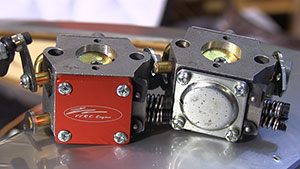 |
| The genuine Walbro (left) can look very much like the knock-offs but seldom perform the same. Click image to enlarge |
Walbro Carburetors
The most-wanted, most-copied RC carb on the planet
Text, photos and video by Tom Hintz
Posted – 3-7-2018
If you fly gas-powered RC planes you likely recognize the name Walbro. For decades Walbro carbs have been regarded as the best nearly everywhere in the RC world as well as in a huge portion of the gas-powered tool markets. However, being regarded as the best makes a product the target of the low-buck, knock-off artists that inhabit the “low-buck at any cost” segment of the RC world. In most cases, noticeably lower prices are possible only because of reduced manufacturing costs. This is where the reality of “careful what you wish for” smacks you right in the pocketbook.
One of the things that strikes me as increasingly foolish is the difference in price between the real Walbro and a knock-off. Genuine Walbro carbs currently sell for about $49.99 (1-25-2018) while most replacement/knock-off carbs cost around $35 and often a bit higher. Saving around $15 by using a lesser carb that could jeopardize a RC plane worth hundreds if not thousands of dollars seems like fiscal lunacy of the first order. But, there are sufficient numbers of such thrift-deceived customers to make producing cheap knock-offs a viable business plan.
I Go Walbro
I have been trying to fly a stock 40 Twin engine to death over the last five years with no success. The stock 40 Twin just keeps on running. Recently it became a little finicky in terms of the carb adjustment. Once I got it dialed in for the conditions that day the stock 40 Twin ran as strong as ever. But, when the weather changed so did the mixture setting. I tried re building the stock carb, but that adjust-to-fly sequence remained. Then I realized that this was a great situation (excuse?) for me to get a Walbro carb to see if the stock 40 Twin acted better with no other changes.
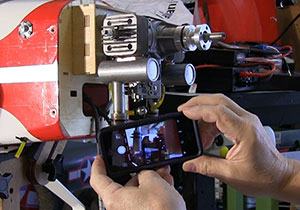 |
| Before I take stuff apart I like to grab some cell phone photos to be sure I get any lines, linkage or wiring back as it is supposed to be. Click image to enlarge |
I remembered seeing genuine Walbro carbs listed at Valley View RC so went to their site and ordered one. The Walbro model used in this Review is listed as a replacement for the stock60T and Valley View RC’sVVRC40cc engines. I noticed that the Walbro at Valley View RC had a trick-looking, red anodized cover plate which I asked about. It turns out that the fancy cover plate is basic bling and branding for Valley View RC who makes the investment to stock Walbro carbs. Still, that red anodized cover does look cool.
I like that the Walbro carb from Valley View RC comes with three throttle arms. One is the simple, short plate and the other two cast metal in different shapes that help the person installing it to get the linkage right for their plane. If you can’t get a clean-working throttle with this Walbro carb from Valley View RC, you need to take a step back and re-think the linkage. I needed to follow my own advice during the production of this story.
The Swap
Before taking anything apart I held the Walbro next to the carb being changed out. This is a good way to see if you have the wrong part before investing time in removing the old piece. I am pretty sure that RC-specific swearing came to be when someone realized they had just taken a plane apart only to find the new piece is the wrong one.
Say Cheese
The advent of cell phones equipped with high-definition cameras can make working on our planes and just about anything else easier with way less frustration. I always take pictures with my cell phone so that when putting all this back together I can check the photos to be sure wires, fuel lines or linkages are going back on where they need to be. I know this sounds too simple to be worth the effort but my personal experience in RC flying over the last 40-some years clearly demonstrates the value of thinking ahead and documenting assemblies.
Simple Swap – Almost
In the process of changing out the stock carb for the Walbro I discovered the reason I had sporadic throttle “oddities”. Specifically, the throttle seemed to hang open for just a second or the throttle closed more slowly than I expected. The pushrod I used to throttle control had developed a bind in it so that had to be changed out as well. As seems to happen regularly, the “fixed” throttle linkage turned out to be better than the original. By using tough 4-40-sized rod inside a plastic tube the chance of flex is all but eliminated.
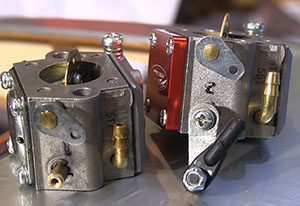 |
| Before bolting anything up I like to match them up and maybe move parts like the throttle arm to the new carb. Click image to enlarge |
While changing out the throttle linkage I changed the pre-installed flat plate arm at the carb for one of the cast versions included. That let me use a good-quality clevis with the hole in the arm drilled to fit it precisely so there is no rattle.
The remaining installation of the Walbro carb went smoothly. Since the stock carb is dimensionally identical to the Walbro carb everything from bolts to gaskets and reed block accepted the new carb without modification. I did take the time to take a close look at the thermal spacer and the reed assembly within it. All of this looked to be perfect, so I cleaned the surfaces and installed the Walbro carb.
First Run Up
Before putting the cowl back on I decided to run the stock DLE 40 Twin with its new Walbro carb in the yard to see if it needed rough tuning. It fired after just a few flips with the choke on and then started as soon as I gave it enough throttle while flipping the prop. For some reason RC carb throttle plates look right when you set them on the bench and almost always need to be opened a bunch to actually get the engine to run.
After getting stock DLE 40 Twin running for a bit to get some heat in it I tweaked the Walbro carb a little. It mostly needed to be richened up on the low end. It seemed a little rich on the top end, so I tweaked that screw towards lean by about a screwdriver blade width, my friend Dennis’s favorite carb adjustment parameter. (He is almost always right, too)
I ran the stock DLE 40 Twin for several minutes, varying the throttle, checking the return to idle from a full throttle run and repeatedly stopping and starting the engine. Everything seemed as fine as it can be in the yard. Now all that is left is to check nuts and bolts one more time, put the cowl on and get it to the field when we get flying weather again!
Walbro Maiden
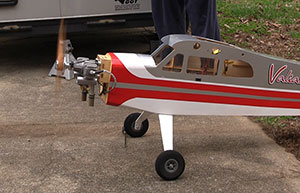 |
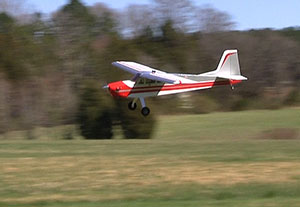 |
| I did run the Walbro in the yard (left) to be sure I had everything working. However, there is no substitute for getting the plane in the air (right) even if it is 30-degrees colder and way windy. I trusted the Walbro carb to stay running and probably would not have done this maiden in the wind with another carb. Click images to enlarge |
|
The weather for this Walbro “maiden” couldn’t have been much worse but it was the first remotely flyable day in over five weeks. I was bordering on the dreaded “RC-withdrawals”. With temperatures in the high 40’s and a knife-like wind out of the North, gusting to over 25mph my Hangar 9 30cc Valiant had its work cut out for it. The cold and first time flying with the cowl on appeared to have richened the Walbro mixture a bit but a small tweak on the high-end mixture screw had the stock DLE 40 Twin sounding very normal.
Shortly after takeoff the DLE 40 Twin came up to full throttle and the response was better than it has been in quite some time. That’s a good thing in the winds as when I rolled the power back on after flying a bit at half-throttle I needed the increased power right then.
For most of the flight the Walbro carb ran just like it had in my yard several days and 30-some degrees-warmer than it was on maiden day. That alone was very different from how the DLE 40 Twin was functioning before the Walbro was installed.
About half-way through the first Walbro maiden flight the DLE 40 Twin suddenly lost a bunch of RPM yet the throttle response itself remained reasonably constant. I brought the Hangar 9 30cc Valiant in for a landing, thinking I needed to do some serious carb adjusting. The culprit turned out to be a spark plug wire that had come off, reducing the DLE 40 Twin to a “one-lunger” that the Walbro was still feeding well enough to produce the power and throttle response I needed to fly and land in such heavy winds.
With both spark plugs now tight and getting electrical impulses the DLE 40 Twin returned to the full throttle performance it showed early in the first flight. This time the RPM and throttle remained the same throughout the flight. Not willing to take any further chances with my prized Hangar 9 30cc Valiant I landed and packed up my stuff.
Conclusions
Video Tour |
The DLE 40 Twin carb made a huge difference in how the DLE 40 Twin ran without replacing anything else from the fuel tank forward. The mixture was remarkably stable even though it was set initially in my yard in very warm temperatures followed by the maidens in way colder and blustery air. These maidens were also the first time the DLE 40 Twin was operated inside a cowl. It turns out the DLE 40 Twin don’t care about no stinkin’ cowls!
With a street price of about $49.00 (3-5-2018) the Walbro carb sure looks like a cheap way to stabilize an engine. I should note that no carb is going to fix an engine that has other problems. However, the Walbro carb will make sure your engine is getting a consistent fuel/air mixture which gets the most out of your engine. Throttle response and power are heavily reliant on the consistency of that mixture. That means the genuine Walbro carb is cheap insurance that is going to find its way onto my other engines as my budget allows or one shows a need for Walbro mixture stability. “Cheaping out” on the decision whether to get a Walbro carb over the somewhat cheaper knock-off could easily cost far more in terms of a damaged airframe. My RC budget does not support that kind of “save-a-buck” foolishness.
Resources
Visit the Valley View RC Walbro Carb page – Click Here
Have a comment on this Review? –Email Me!
All Flyingrc.net written, photographic and drawn materials are property of and copyright by Tom Hintz and Flyingrc.net 2013-2020 Materials cannot be used in any way without the prior written permission of the owner.
Privacy Statement


